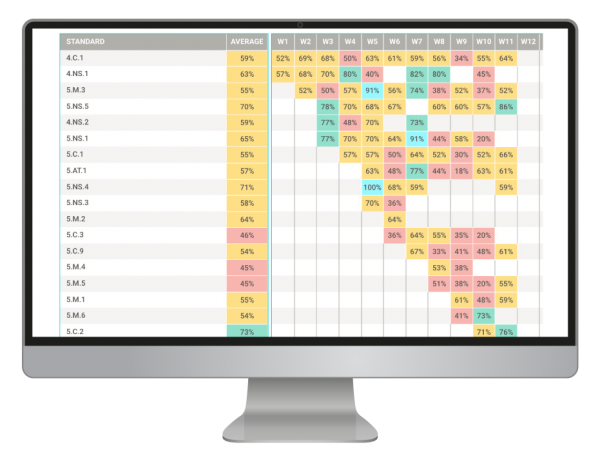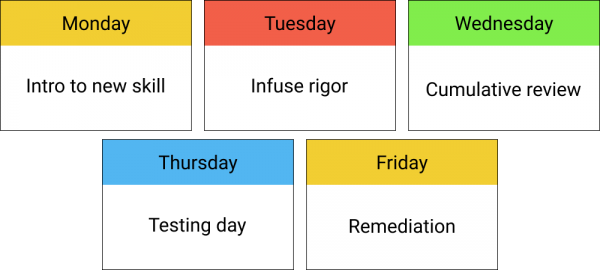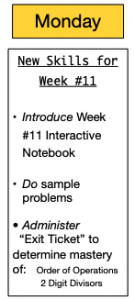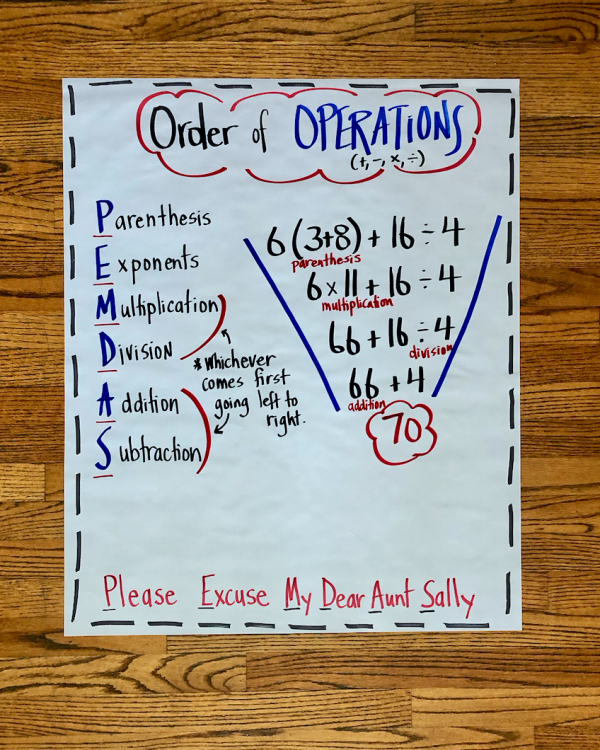It’s been proven time and time again that children thrive when they’re given structure. The students in your math classroom are no different, which is why a predictable lesson plan week in and week out is so important for their academic success.
As a math curriculum that was made by teachers for teachers, structured lesson plans are at the heart of Vimme Learning. Vimme’s lesson plans help you find your flow as a teacher, and give your students the guard rails to successfully learn math.
Let’s walk through what each week looks like in a Vimme classroom. Here we’ll sit in on a 5th grade class during week 11 of the school year, where they’ll be learning about order of operations and two-digit divisors.
Monday — Introducing new skills
Every Monday, your students will dive head-first into a new math concept. First things first, let’s give them the tools they need for success this week!
The best place to start is with Vimme’s interactive notebooks. Interactive notebooks are worksheets that walk through helpful vocabulary and strategies for tackling each week’s concepts. Our teachers have found a lot of creative ways to incorporate these into their lesson plans. You can:
- Print out this week’s interactive notebook, and have your students cut and paste it into a physical notebook.
- Copy the interactive notebook into a Powerpoint presentation to walk through with your class.
- Print and bind the entire school year’s worth of interactive notebooks to create a “textbook” for your class.
Interactive notebooks introduce vocabulary, concepts and strategies for working through problems.
In addition to interactive notebooks, your students can lean on Vimme’s anchor charts as a learning aide. These are quick, visual reminders about important equations and vocabulary that can be replicated and posted to the wall of your classroom. These can easily be sketched out before class begins — all you need is a marker and a pad of easel paper.
Posting Vimme’s anchor charts in your classroom gives students a visual reference for the week’s skill, in this case order of operations.
With their interactive notebooks in hand and an anchor chart on the wall, your students are ready to tackle sample problems to put the new skills into practice. At the end of the day, you’ll administer an exit ticket to test their initial understanding of this week’s concepts.
Tuesday — Infusing rigor
Now that your students have been introduced to this week’s skill, it’s time to kick things up a notch. Vimme naturally infuses rigor into each lesson plan, so students go beyond rote memorization and learn to actually apply the concepts they’ve learned.
While there’s no avoiding equations in subjects like order of operations and two-digit divisors, Vimme places an emphasis on story problems whenever possible. These real-world applications challenge your students to think about each new skill from a variety of angles, and naturally infuses rigor into your weekly lessons.
Vimme includes basic, emerging and rigorous questions to cater to students of all achievement levels.
Since Vimme is a cumulative, spiral curriculum, circling back on previous skills is just as important as learning new ones. For example, during week 11 of 5th grade students will be reintroduced to two skills from previous weeks: volume and area.
For most of the period, your class will tackle sample problems blending the new and previous skills. To jog their memory about volume and area, our 5th grade, week 11 students can refer to earlier pages of their interactive notebook. You can also pull out the anchor charts for those skills and put them back up on the wall as a visual reminder.
Your exit tickets can mix and match questions with text answers, multiple choice with a single answer and multiple choice with multiple answers.
And as with Monday, Tuesday ends with a quick exit ticket to gauge your class’ understanding of both the week’s new skill and previous skills. At this point they’ve learned all the skills they’ll need for the cumulative assessment. Tomorrow it’s time to check their mastery and patch up problem areas as a class.
Wednesday — Preparing for the cumulative assessment
At the midpoint of the week, it’s time to review for Thursday’s cumulative assessment. On Wednesdays, you’ll break your class into peer groups to work on this week’s skills.
Vimme gives you a handful of great tools to help your students work toward mastery in groups. Peer tutoring is a great way for your students to flex their math skills while helping their classmates.
- Vimme’s Assignment Builder lets you quickly whip up worksheets that cover problem areas you saw on this week’s exit tickets. Or you can use publicly available assignments created by other Vimme teachers across the nation.
- Cumulative quiz answer keys for each week can be found under the Resources tab on your Vimme dashboard.
- Videos offer tips on tackling math concepts, with many hosted by Vimme’s founder and former teacher of 25+ years, Tammy Laughner.
Thursday — Testing day
It’s go time! Many Vimme teachers choose Thursday to administer Vimme’s cumulative online assessment, though you’re free to choose whichever day works best for your classroom. While the majority of the assessment covers skills you taught this week, any concept that’s shown up in previous weeks is fair game. Thanks to spiral review, your students will be well prepared for the challenge.
In addition to new skills, the cumulative quiz for 5th grade week 11 includes volume, area, exponents, conversion of measurements and other concepts from previous weeks.
Questions are instantly graded as soon as students submit their answers, and posted to your teacher dashboard on Vimme. With the click of a button, you can use Test Review mode to go over each question as a class, and focus on the ones that stumped the majority of your students.
Vimme’s grade book is color-coded, so you can easily see how well your class did on the cumulative assessment and other assignments.
Vimme’s real-time data lets you immediately identify the areas where your students are succeeding and where they may need a helping hand. You can disaggregate the data by question, by academic standard or by test score to get a clearer picture of each student’s performance. Armed with that knowledge, you can confidently group students for remediation on Friday.
Friday — Remediating
It’s finally Friday, and your students are ready for remediation. The end of the week is a great time to fill in the gaps while the cumulative assessment is still fresh in their minds.
You may have your own system for handling remediation, or you can follow in the footsteps of many Vimme teachers who use their real-time data to sort their students into groups based on problem areas.
From Vimme’s Question View, you can easily see which question your class struggled with on the cumulative assessment. Here you’ll see each question, whether a student got the question right or wrong, and which answer they submitted.
Vimme automatically highlights focus areas in yellow (75% or less of students answered correctly) or red (50% or less of students answered correctly). With the click of a button, you can see which students answered those questions incorrectly and sort them into groups for remediation.
As one final point of order before the weekend, students will get a sneak peek at the new skill they’ll dive into next Monday — in this case mean, mode, median and range. Next week’s lesson will follow the exact same structure
Vimme Learning gives your classroom a proven structure for success for every week of the school year. With our free trial, you can try that structure in your classroom with no obligations for 6 weeks. Click here to start your free trial, and set your students up for success for the semester ahead.












